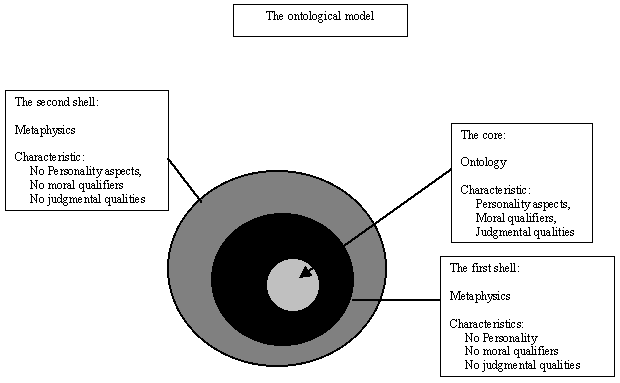|
 
 
Tractate 5 : The Error of Leibniz (continued)
Error through the active process of extrapolation as opposed to the passive process of definition
Definition is one means by which concepts of perception can be established and legitimized. Process is another. There is no doubt that establishment of the legitimacy of a perceptual concept through definition is a process, but it is a passive process. The other form of establishing the legitimacy of a perceptual concept is through an active process. In this case the process would be what we would call the process of extrapolation.
‘Omni-‘ means all. ‘All’ implies the other extreme of nothing. As we understand it, knowledge, knowing, exists. If knowledge, knowing, exists, even if it is infinite, it is possible for there to be a total summation of knowledge – knowing. It is possible for there to be the universal set of knowledge or what we might call the ‘whole’. On the other hand, the least amount of knowledge, knowing, is no knowledge, no knowing, no existence of knowing, no existence. Whether this state of existence exists or not is debatable. But we are not here to examine that particular issue. We are here to examine the issue regarding the validity of theodicy. As such we must look at the very minimal extreme of knowledge’s existence, the very minimal extreme of knowing.
On one end of the extreme of knowing appears to be the whole. On the other end of the extreme of knowing appears to be none, no, zero knowledge. There is, however, no apparent knowing existence we are presently capable of perceiving which is the opposite of a knowing existence.. As such there is no apparent existence of negative knowledge, negative knowing. There is knowledge about negative things but no apparent knowledge about the opposite of knowledge.
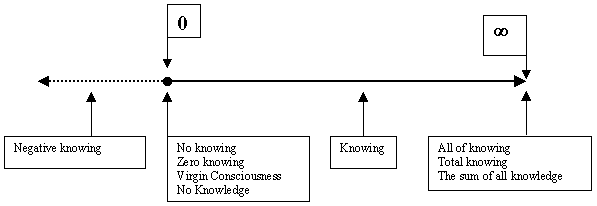
Knowledge therefore reaches from the one extreme to another. The terms, infinity and zero represent the extremes. The extremes reach from the concept of an infinite quantity of the item, to the possibility of there being none at all, no knowing, no existence, the rejection of Descartes’, ‘Cogito, ergo sum, I think, therefore I am.’. It does not get any less than none at all.
As such the ‘whole’, the summation, total knowledge is a concept that exists for knowledge. This in turn makes the ‘whole’ the greatest possible accumulation of knowledge of which we are capable of understanding, perceiving. It is, therefore, logical to assign the concept of omniscience to the most all-encompassing entity of which we can conceive.
This perception of ‘omni-‘ applies similarly to the concepts of power and presence. We cannot conceive of anything less than zero power, no power, and we cannot conceive of anything less than zero presence, no presence. As such the concepts of omnipotence and omnipresence take on a legitimate form of being a possible characteristic for God, for the ‘whole’.
What about benevolence? One may say benevolence also has a maximum of infinity and a minimum of zero. But does it? When we think of ‘good’ we think of its opposite evil. Benevolence is unlike knowledge, power, and presence for benevolence does not stop at zero on the line of continuance. Benevolence, ‘good’, on a line of continuum moves past zero and accelerates into the region of its opposite, ‘bad’. The continuum upon which benevolence is located is a line not a ray and it extends in both directions infinitely far. In addition benevolence does not have a starting point which is a constant. Its starting point fluctuates with the fickleness of what the social perceptions of ‘right’ and ‘wrong’ define it to be depending upon the culture, times, and convenience of humankind. For example,taking a life may be murder (wrong) in one case, but socially correct in another (war, capital punishment)
One may say, ‘The extremes of knowledge, power, and presence also extend infinitely far in two directions.’ But does it? How can one have something less than no knowing, no power, no presence. There is nothing of which we, as a specie, presently conceive that applies to the concept of the opposite of power and presence.
As such ‘omnibenevolence‘ does not apply to the concept of God unless one rejects what our specie has developed as characteristics of God over the last ten millennia. It is not our place, within this discourse, to say this cannot be done, but on the other hand neither is it our place, within this discourse, to say this can or should be done. As such we are limited, in this discourse by the constraints of time and space, to discuss one small error of philosophy.
Part II: Resolving the issue with a new metaphysical perception
There is a fundamental flaw in both the process of definition and the process of extrapolation Leibniz used when he created the term theodicy.
Theodicy adds a fourth characteristic to God, omnibenevolence
There are two means of developing perceptions of God. One can develop a perception of God through the passive process of definition as was addressed in Part I of this tractate or one can develop a perception of God through the active process of extrapolation. Extrapolation is most commonly used in terms of two-dimensional lines n a planar graph or two-dimensional lines in three-dimensional space. However, extrapolation can also be used in terms of three-dimensional forms in three-dimensional space immersed in the fabric of time and space creating what we call ‘real’ perceptions.
Developing a perception of God, through the active process of extrapolation, is much like putting together a solid three-dimensional puzzle. Three-dimensional puzzles need to start with the inner piece, the core, the origin, and is considered the foundation of the puzzle.

If one does not place the core first, then one is forced into building the first shell around an empty inner core.
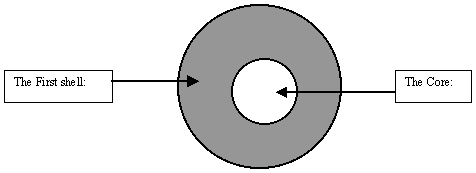
Once a shell is built around an empty core one cannot go back and fill in the core without dismantling the puzzle and starting over. Such a process is unstable and eventually will collapse upon the originators, be they religions, philosophies, or scientific theories.
So where does one begin in terms of putting together an abstractual understanding of a three dimensional puzzle of God? One does not begin with ‘faith’ nor does one begin with ‘observation’. One begins with ‘reason’.
Faith cannot act as the core for faith is diversified. Faith varies with culture, race, time, etc. This is not to say one ignores faith for one cannot begin with a statement of what the core is unless one has ‘faith’ in what it is one reasonable ‘believes’ makes up the core concept of God.
Observation cannot act as the core for very act of observing may in fact ‘change’ what it is one ‘observes’. Such a concept is not only reinforced by the present day perception of ‘critical philosophy’ but by the scientific concept known as: The uncertainty principle. In addition, if we cannot demonstrate in an observable fashion what it is we establish as a ‘reasonable’ core, the concept we profess to be the core loses its very characteristic of being reasonable and thus losses its potential to be a believable core concept. In short such a core is unsubstantiated by science – what we observe, religion – what we believe, and philosophy – what we reason.
The core and the first shell therefore emerge out of the most primitive concepts found within our perceptual knowledge.
One would be truly arrogant to think they, personally, can build, create, the primary pieces: the core and the first shell of the puzzle.
This is where Leibniz erred. Leibniz was arrogant enough to believe he was both capable and intelligent enough to dismantle what humanity had spent thousands of years putting into place. Leibniz believed he alone could reestablish humanity’s core concept of God.
When building his model of God, Leibniz presumptuously removed the core piece of the puzzle humanity had put into place. Having done so, Leibniz then proceeded to dismantle the first shell humanity had placed around the core.
Leibniz then, arbitrarily, replaced the core and first shell with his own version of a core, which he believed, should then act as ‘the’ metaphysical model of God humanity should accept as their starting point for understanding ‘what’ God was.
The term God is being used not as a religious/ontological term but as a philosophical/metaphysical term. Before one can understand God ontologically one must understand God metaphysically. Leibniz did not make this distinction and this was where he made his mistake in terms of understanding God through the active process of extrapolation.
Thus Leibniz moved the study of God from the traditional model of metaphysics into being the study of God from the new model of ontology. Thus it is metaphysicians became ontologists masquerading as metaphysician. Granted such masquerading had been, with the blessing of the church, occurring prior to Leibniz but it was not until Leibniz that the core of omniscience, a metaphysical term, was replaced with a core of omnibenevolence/theodicy, an ontological term
Graphically such a transformation would appear as:
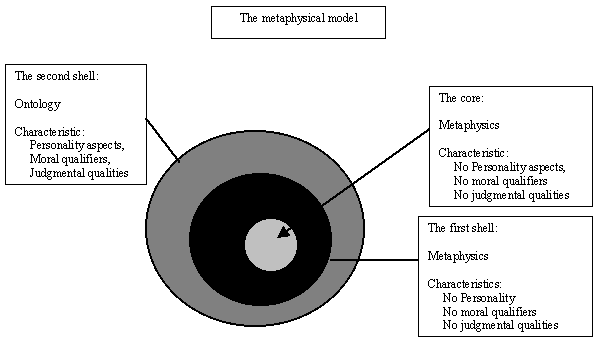
With the aid of Leibniz, transforming into the ontological model:
It had taken our specie tens of thousands of years to put the core and first shell into place.
So let’s look at the active process of building an understanding of God through extrapolation in order to understand how Leibniz went ‘wrong’.
Placing the first piece the core of the puzzle:
The Core: Omniscience:
What was it our specie had been working to establish as their understanding of the essence of God? The primary piece, the core, comes from one of the ‘omni-‘ concepts. The piece was omniscience, not just knowing, not just knowledge, but rather ‘all’ knowing, ‘all’ knowledge.
Such an aspect involves no ‘personality trait’, is ‘non-judgmental in nature’, involves no ‘moral’ qualifiers. Such an aspect is simply a state of existence or is not a state of existence. Something either is ‘all’ knowing or it is not ‘all’ knowing.
Thus the core emerges out of metaphysics as:

Without ‘knowing’, without awareness of itself, without knowing itself, God would have no significance, rather God would just ‘be’. Without awareness of itself, God would simply be a ‘passive’ form of existence as opposed to an ‘active’ form of existence. The concept regarding ‘active’ versus ‘passive’ action will be more fully addressed in Tractate 6: Kant.
We as a specie, then expanded our idea of God as we evolved and grew. We expanded our idea of God to be a ‘very’ knowing entity and finally into being what we conceive God to be today which is the summation of all knowing, all knowledge and the self-awareness of Its being so . In short we have expanded God to be the ‘whole’ of all we believe we are capable or incapable of discovering. This is the core foundation of religions today. This not to say religions have not added various characteristics of personality, moral qualifiers, and judgmental quantifiers to God for they have taken the foundations of metaphysics and expanded upon the basics metaphysics has established as the foundation of a metaphysical definition of God. These additions, however, fall into the field of ontology rather than metaphysics.
All characteristics added to a perception of God are not ontological in nature for many such characteristics form shells beyond the layers ontology applies to the core and first shell formed by metaphysics.
It is reason/philosophy which must sort through what it is we observe/science and what it is we believe/religion and choose what it is which most reasonably acts as the core characteristic of God. As such it is ‘all’ knowing, knowing of all, the summation of knowledge which most reasonable acts as the core created through the process of ‘active’ extrapolation.
And why is this the case? Without ‘knowing’, without awareness, no process of extrapolation could occur let alone any form of ‘active’ extrapolation.
So the first piece, the core, is the concept of omniscience. Without any knowledge and awareness of it, the knowing of knowledge, there would be no ‘God’ as we conceive of the idea today.
After placing the core, the next task becomes building the first shell regarding our understanding of ‘what’ God is.
The First Shell: Omnipotence and Omnipresence
After placing the core piece, where does one go to find the pieces, which will form the first shell encompassing the core piece of omniscience? One again goes to the depository of knowledge built by humanity. But why go to the depository of knowledge built by humanity? Could there not be another source other than human knowledge? Perhaps but such a source is not available to us at this time.
A shell around a core is naturally more expansive than the core. The first shell appears to expand upon the core. But the first shell, in actuality does not expand upon the core but rather only appears to do so. In truth the first shell encompassing the core, protects the purity of the concept of the core itself. The first shell helps us as a specie to understand the core. This shell is composed of humanly crafted concepts placed around the core in as close a proximity to the core, as we are humanly capable of doing.
As such, this shell must contain concepts as closely allied to the core as possible in order to not contaminate or compromise the core concept we have metaphysically/philosophically/reasonably, cosmologically/scientifically/observationally, and ontologically/religiously/believably built of regarding the whole itself.
To discard the product we obtained through the use of the only perceptual tools we appear to possess as a specie, reason – observation – belief, is an action which leaves us with no foundation of action from which we launch our effort to understand not only our physical reality but to understand our abstractual Reality.
As a specie, we have attempted to attain this proximity in order to expand the puzzle. As a specie, we have subconsciously attempted to construct the core and first shell in such a way that no ‘air’ pockets of irrationality would be trapped between the core and the first shell we put into place. We did not want air pockets which would warp our picture of God.. We were truly sincere in our desires to know ‘what’ God, what the whole was in order to understand ‘what’ we were and ‘why’ we existed.
The shell we finally established as a specie was composed of two humanly understandable concepts, power and size. Neither of these ‘had’ to be put into place for the core, omniscience, implied both. We however, as a visual creature, wanted desperately to understand, to visualize God, for we recognized that to do so was the key to our most haunting questions: Where are we? What are we? Why do we exist?. We recognized size to be a pictorial concept and being a visual creature we felt the need to be able to picture the size of God, in order to better understand God.
As such, the first shell is composed of the concept of size. God must be big enough to ‘contain’ all knowledge, knowing, and awareness of its knowing.
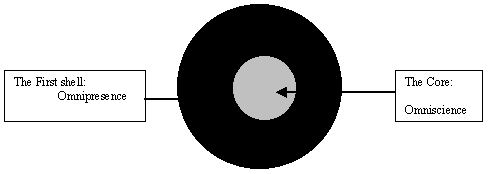
Size was a puzzle piece characterized by the same three principles as omniscience:
- Concepts of omni’s help us as a specie to visualize a perception of what we hoped was a ‘true’, accurate picture of God.
- Concepts of omni’s are nonjudgmental in nature.
- Concepts of omni have had a beginning point. In other words omni’s were composed of a continuum stretching from zero to infinity.
The question then became, were there any other pieces of the puzzle that should or could be used to build the first shell, which was to wrap around the core concept of God, omniscience. Were there any other pieces, which could be used as a protective layer for omniscience?
After thousands of years of looking, our specie found what it considered to be just such a piece. We found a piece that helped us visualize God, was nonjudgmental, and had a beginning point of zero, an end point of infinity, and was implied by the core concept of omniscience. This piece was the summation of power, all power, omnipotence.
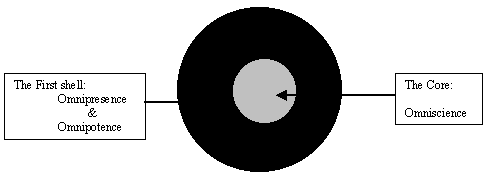
As a specie, we recognize the concept of power but we do not recognize the concept regarding the opposite of power. The question arises: Is power used for ‘evil’ purposes the opposite of power used for ‘good’? That is not the issue we are addressing. What we are addressing is the concept of power itself and who would deny that having the ability to perform, having the ability to initiate ‘evil’, ‘bad’, ‘inappropriate’, and ‘abusive’ actions is any less a form of simple, pure, raw power than the having the ability to perform, having the ability to initiate ‘good’, ‘nice’, ‘appropriate’, and ‘warm’ actions.
As such there is power and there is a summation of power. Power can be understood to exist and be diminished all the way down to a point of having no power at all, zero power, but after that we cannot conceive of power being reduced any further. We can reduce power to the point of no power, pure power, without debating, without being judgmental, in terms of reducing it any further.
Leibniz and the error of addition
Leibniz added omnibenevolence to the first shell.
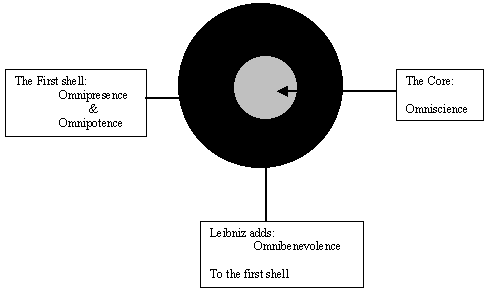
Leibniz did not add omnibenevolence to the first shell based upon reason but rather Leibniz added omnibenevolence to the first shell based upon his personal perception that such a characteristic logically belonged with other impersonal, nonjudgmental, nonmoralistic characteristics of God.
Such an action is based upon faith rather than reason and faith is the perceptual tool of ontologists.
Thus it is, Leibniz began his examination regarding his concept of theodicy. It is from the very definition of the term theodicy that Leibniz, as a philosopher, should have begun to ask the question, ‘Does the concept of ‘omnibenevolence’ belong as a part of this first shell?’
If Leibniz had began his examination of the concept of theodicy with such a question, he would have recognized that ‘omnibenevolence’ does not meet the same standards we expected of omnipotence and omnipresence.
The three standards we required of the puzzle pieces forming the core and first shell ware:
Standards required of the puzzle piece forming the core and first shell:
- Concepts of omni’s help us as a specie to visualize a perception of what we hoped was a ‘true’, accurate picture of God.
- Concepts of omni’s are nonjudgmental in nature.
- Concepts of omni have had a beginning point. In other words omni’s were composed of a continuum stretching from zero to infinity.
Omnibenevolence meets the first criteria of the first shell. Omnibenevolence helps us visualize, form a picture of God, but omnibenevolence is a judgmental concept. Benevolence depends upon one’s point of view. What is benevolent and what is not benevolent depends upon ones culture, religion, personal perception, time in history and therefore does not meet the second criteria required of the pieces to be placed in the first shell.
But what of the third point required of various forms of ‘omni’s’?
0003. Concepts of omni’s have a beginning point. In other words omni’s sre composed of a continuum stretching from zero to infinity.
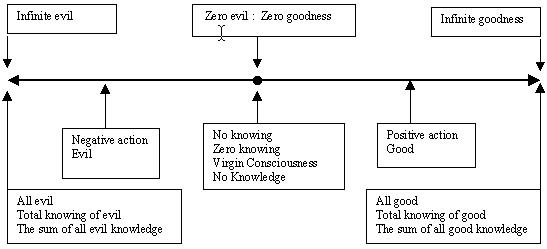
It is clear from the graphic that omnibenevolence does not fit the parameter set out by the third characteristic required of the various forms of omni’s. Omnibenevolence is not only subject to the concept of judgment but omnibenevolence, rather than finding itself beginning at the point zero and moving to infinity, finds itself having no beginning point and two rather than one point of infinity.
Omnibenevolence did not fall within the standards required by the passive action of definition required of a term encompassing the prefix, omni. In addition, omnibenevolence did not rise to all three standards required of a term encompassing the prefix, omni by the active action of extrapolation.
Leibniz ignored the requirements, which both active action and passive action placed upon our most fundamental metaphysical understandings of God. Leibniz striped away the first shell of God. He then took these two pieces, omnipotence and omnipresence, and mixed them with the concept of omnibenevolence. By doing so, Leibniz developed a less cohesive mixture of omni’s to apply to the core of omniscience.
Leibniz then proceeded to mold and form this new but less cohesive mixture around our core concept of God. Due to the substandard qualities of this new omni mix, Leibniz created a bubble of air between the first shell and the core surrounding our understanding of God, and the result has been the rotting away, drying out, cracking of the first shell. This in turn has initiated a form of dry rot within the core itself.
The result has been the acceleration of hostility, anger, and rage individuals feel towards God which are perpetuated by the perception that God ‘allows’ ‘evil’, ‘bad’ things to happen to ‘good’ people. The natural extension of such perceptions leads to the belief that God does not ‘care’ about us.
It is time to remove omnibenevolence from the mix composing the first shell regarding our understanding of God. It is time to reestablish the fundamental metaphysical characteristics of the first shell as it had previously been. It is time to move on in our efforts to understand God, understand ourselves, and understand our responsibilities to the whole within which we find ourselves to exist, so we can fulfill these very responsibilities.
It is only natural to ask several questions at this point. Are we willing to let go of theodicy being a metaphysical characteristic as Leibniz established? Are we willing to accept the concept of omniscience, omnipresence, and omnipotence as the first key pieces leading to the understanding of God: If the answer is yes, then the question becomes, ‘What next?’
If omniscience is the core and omnipotence and omnipresence compose the first shell surrounding omniscience, than what is the composition of the next layer, the composition of the second shell regarding our understanding of God?
The Second Shell: Answers to three questions
Do we have any ideas regarding what the second shell should be?’ Subgroups of humanity thought it might be composed of their particular religious dogmas. These dogmas ranged from Hinduism, Christianity, Islam, Buddhism, Judaism, Wickam, New Thought, Zorasticism, etc. But religion proved to be not only ‘inter’ and ‘intra’ adversarial but adversarial towards our natural desire to observe/science and our natural desire to reason/philosophy.
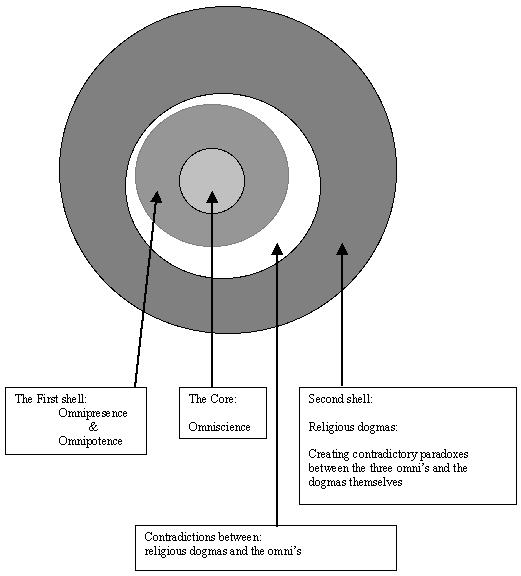
In spite of the adversarial positions religious dogmas took, these subgroups of humanity insisted upon placing such dogmas around the first shell, omnipresence, omnipotence, and the core of omniscience. This second shell is in place even today.
The very fact the second shell of religious dogmas and the first shell of the omni’s are not a tight fit is indicated by the insurmountable contradictory dilemmas constantly emerging out of the philosophical, scientific, and religious obfuscating dilemmas generated when attempting to reconcile the religious dogmas, scientific models, and philosophical theories with the metaphysics of the omni’s.
The same process of attempting to build a second shell occurred with science and it’s concept of Aristotelian passive observation and with philosophy and its concept of Kantian active observation. Neither religion nor science nor philosophy appears able to adequately build a second shell alone. It appears we will need to build a second shell incorporating all three forms of perception.
It appears the core and first shell must by definition as well as by the active action of extrapolation remain the domain of metaphysics. But, one may ask: Are not concepts of omniscience, omnipotence, and omnipresence aspects of religion versus being aspects of metaphysics? No, for the concept of the summation of knowing, summation of knowledge, summation of the whole, summation of power – the ability to act, is nothing short of the summation of what it is we observe/science and the summation of what it is we believe/religion emerging out of the most basic foundation of our ability to reason. In short the foundation is metaphysical in nature.
It is from metaphysics itself that we find religion, science, and yes even philosophy itself emerges.
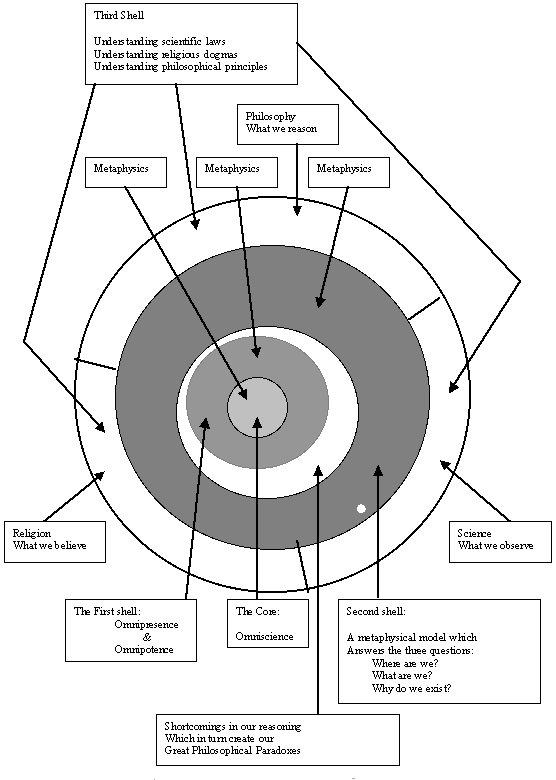
There appears to a complete form of shell missing between the first shell and the third shell we have constructed. This incomplete second shell should be composed of a metaphysical system, which answers the three questions: Where are we? What are we? and Why do we exist? Our present metaphysical systems do not seem to fit well with the first shell and core which metaphysics has established. Dispite all our attempts to establish a metaphysical system which answers the three basic questions which have haunted our specie for what seems to be time eternal, there appears to be a lack of a consensus between ourselves as individual members of our specie in terms of ‘Where it is we think we are.’ ‘What it is we think we are.’ and ‘Why it is we think we exist.’
As a specie we appear to be historically leaning towards the concept that the second shell may be composed of fragmented pieces of science, religion, and philosophy. These fragmented pieces all appear to be simultaneously providing us with an understanding of the three questions.
Where are we?
Science, religion, and philosophy all appear to suggest: We are located within the whole.
What are we?
Religion, philosophy, and science all appear to suggest: If we are located within the whole, then we are a piece, we are a part of the whole.
Why do we exist?
Philosophy, science, and religion all appear to suggest: If we are in within the whole and if we are a part of the whole, then we exist to interact with the whole, we exist to aid the whole in being what it is the whole itself is.
Graphically we can demonstrate such a perception as:
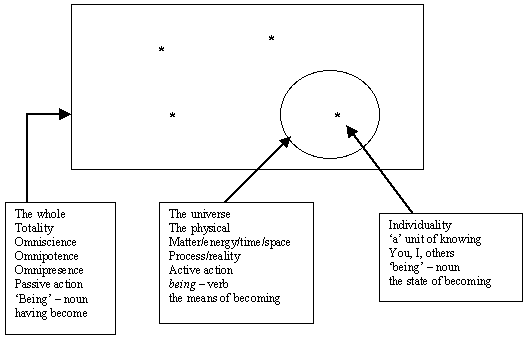
Such a perception is best described metaphysically as ‘being’ being ‘Being’
|
|
|








